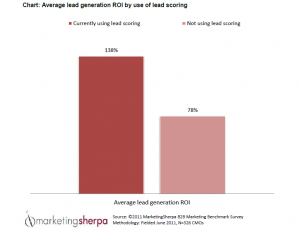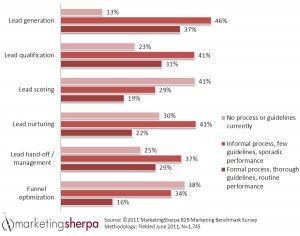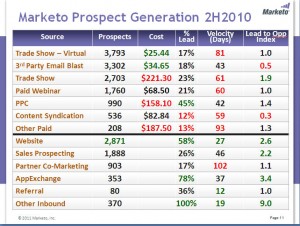Originally published on B2B LeadBlog
Last month’s webinars on leveraging the human touch to drive leads, presented for the B2B Lead Roundtable and Marketo, prompted a great question: “What should I look for in a teleprospector?”
Unfortunately, that can’t be answered with a fast, convenient sound bite. That’s why I’m going to do my best to respond here in my inaugural blog post.
Over the past 15 years, I’ve been involved in hiring hundreds of teleprospectors. Along with Brian Carroll, I was one of the co-founders of InTouch, now MECLABS Leads Group. Fortune 100 companies from a broad base of industries hire us to do teleprospecting for them; they know the value of the human touch to optimize their lead generation efforts. It seems like we’re always on the lookout for powerful teleprospectors to support these accounts, and over the years, we’ve pinpointed some of the critical traits that are inherent in every top performer:
An abiding desire to serve. Teleprospectors must sincerely want to help others, because that’s what they’re going to be doing all day, every day. When they conclude a conversation with a prospect, we want that prospect to feel like the call added value to his day — regardless of his timing to buy. To make that happen, teleprospectors must have an attitude of service, a sincere eagerness to help others. Furthermore, not only must teleprospectors serve the people they call, they must gain real satisfaction from serving their colleagues as well. There’s no room to be territorial, because they’re going to be passing leads to someone else who will take them to the next level in the sales process.
The focus to follow process. A full-time teleprospector can expect to make 80 to 100 calls a day. This entails far more than simply smiling, dialing and spouting a script. After all, we use call guides, not scripts; read this or watch our most recent webinar to find out why. Our team must be fully engaged in each and every call to successfully execute proven, tested tactics that drive opportunity. It doesn’t matter how clever or charming a candidate is; if he’s unwilling to follow process, you don’t want him calling.
Tenacity and patience. We’re not bell-ringers here; people aren’t getting leads every three minutes. It can typically take 8 to 19 calls to reach a prospect. Teleprospecting is not for someone who thrives on instant gratification.
Empathy and strong listening skills. They must be able to put themselves in their prospects’ shoes and anticipate their needs. That means listening intently to pick up on the subtle signals that indicate where a prospect is on the buying process. You would be impressed at the engagement we get from prospects who can sense that our teleprospectors are paying close attention. People know when they’re genuinely being listened to.
Curiosity coupled with a love of learning. People with this combination like to be informed; they’re well-read and take pride in keeping up with what’s happening in the business world. This is a key trait for our teleprospectors because they can ultimately work with a variety of clients. While we train and coach them extensively, they must be ready to intelligently discuss any number of topics ranging from manufacturing devices to educational programs.
A clear, measured, confident speaking voice. This is lower on the list because, more than any of the other qualities, it can be taught.
Obviously, you’re not going to be able to scan a resume and identify these skills, and you can’t take someone from outside sales, plop them down with a headset and a script, and expect success. Road warriors are accustomed to closing; hunting for opportunity requires a completely different skillset and very few people have both.
To find great teleprospectors, we have candidates undergo multiple interviews and tests, including role-playing and psychological analyses, to identify strengths and opportunities for growth. You just never know where you’re going to find out a stand-out employee. Case in point is Mark Wicka, our Senior Business Development Representative. He came to our company as a temp and had never worked in any kind of lead-generation role. Eleven years later, he’s still here. (And talk about work ethic — he’s never called in sick during those entire 11 years!)
He began his career here generating leads for our clients. But these days, we’re using his skills to generate leads for MECLABS while mentoring and supervising a team that is doing the same. He thrives on learning; when he worked for our clients, he dove into educating himself about their industries and products. Now that he drives business for MECLABS, he has become expert in all aspects of lead generation. Yet, he’s the most humble guy you’d ever meet; he never comes across as a know-it-all, just very informed and authentic. His spirit of service shines through in everything he does. Consider what he has to say about what motivated him to come to MECLABS:
“I feel like fate brought me here. I worked in print advertising, but it didn’t resonate. I didn’t think it was very effective and I wanted to work for a company where I knew their solution worked,” he recalls. “I was doing more than look for a job, I wanted to work for an organization that I believed in. I’ve found that at MECLABS.
“My goal is to be an intelligent follower. There’s no disgrace in following, the person who follows leaders most effectively is the one who develops leadership most rapidly. I’ve had great mentors here — when I started it was my program managers. Today, it’s Brian Carroll and Flint McGlaughlin (CEO and Managing Director of MECLABS). Their success is my success.”
I would love to hear your thoughts about the qualities you think are essential to be an effective teleprospector. Are you surprised by my conclusions? Are there other skills you think are just as important as the ones I’ve listed? Do you want me to expand on any of these thoughts? Feel free to comment below.















